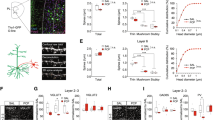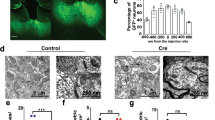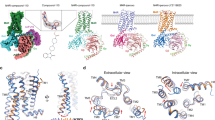Abstract
Schizophrenia patients exhibit deficits in signaling of the M1 subtype of muscarinic acetylcholine receptor (mAChR) in the prefrontal cortex (PFC) and also display impaired cortical long-term depression (LTD). We report that selective activation of the M1 mAChR subtype induces LTD in PFC and that this response is completely lost after repeated administration of phencyclidine (PCP), a mouse model of schizophrenia. Furthermore, discovery of a novel, systemically active M1 positive allosteric modulator (PAM), VU0453595, allowed us to evaluate the impact of selective potentiation of M1 on induction of LTD and behavioral deficits in PCP-treated mice. Interestingly, VU0453595 fully restored impaired LTD as well as deficits in cognitive function and social interaction in these mice. These results provide critical new insights into synaptic changes that may contribute to behavioral deficits in this mouse model and support a role for selective M1 PAMs as a novel approach for the treatment of schizophrenia.
Similar content being viewed by others
Log in or create a free account to read this content
Gain free access to this article, as well as selected content from this journal and more on nature.com
or
References
Anagnostaras SG, Murphy GG, Hamilton SE, Mitchell SL, Rahnama NP, Nathanson NM et al (2003). Selective cognitive dysfunction in acetylcholine M1 muscarinic receptor mutant mice. Nature Neurosci 6: 51–58.
Barak S, Weiner I (2011). The M(1)/M(4) preferring agonist xanomeline reverses amphetamine-, MK801- and scopolamine-induced abnormalities of latent inhibition: putative efficacy against positive, negative and cognitive symptoms in schizophrenia. Int J Neuropsychopharmacol 14: 1233–1246.
Bekinschtein P, Weisstaub N (2014). Role of PFC during retrieval of recognition memory in rodents. J Physiol Paris 108: 252–255.
Berman JA, Talmage DA, Role LW (2007). Cholinergic circuits and signaling in the pathophysiology of schizophrenia. Int Rev Neurobiol 78: 193–223.
Brigman JL, Ihne J, Saksida LM, Bussey TJ, Holmes A (2009). Effects of subchronic phencyclidine (PCP) treatment on social behaviors, and operant discrimination and reversal learning in C57BL/6J mice. Front Behav Neurosci 3: 2.
Byun NE, Grannan M, Bubser M, Barry RL, Thompson A, Rosanelli J et al (2014). Antipsychotic drug-like effects of the selective M4 muscarinic acetylcholine receptor positive allosteric modulator VU0152100. Neuropsychopharmacology 39: 1578–1593.
Caruana DA, Warburton EC, Bashir ZI (2011). Induction of activity-dependent LTD requires muscarinic receptor activation in medial prefrontal cortex. J Neurosci 31: 18464–18478.
Casimiro TM, Sossa KG, Uzunova G, Beattie JB, Marsden KC, Carroll RC (2011). mGluR and NMDAR activation internalize distinct populations of AMPARs. Mol Cell Neurosci 48: 161–170.
Chan WY, McKinzie DL, Bose S, Mitchell SN, Witkin JM, Thompson RC et al (2008). Allosteric modulation of the muscarinic M4 receptor as an approach to treating schizophrenia. Proc Natl Acad Sci USA 105: 10978–10983.
Dean B, McLeod M, Keriakous D, McKenzie J, Scarr E (2002). Decreased muscarinic1 receptors in the dorsolateral prefrontal cortex of subjects with schizophrenia. Mol Psychiatry 7: 1083–1091.
Digby GJ, Noetzel MJ, Bubser M, Utley TJ, Walker AG, Byun NE et al (2012). Novel allosteric agonists of M1 muscarinic acetylcholine receptors induce brain region-specific responses that correspond with behavioral effects in animal models. J Neurosci 32: 8532–8544.
Elliott R, Lythe K, Lee R, McKie S, Juhasz G, Thomas EJ et al (2012). Reduced medial prefrontal responses to social interaction images in remitted depression. Arch Gen Psychiatry 69: 37–45.
Ghoshal A, Conn PJ (2015). The hippocampo-prefrontal pathway: a possible therapeutic target for negative and cognitive symptoms of schizophrenia. Future Neurol 10: 115–128.
Gibbons AS, Scarr E, Boer S, Money T, Jeon WJ, Felder C et al (2013). Widespread decreases in cortical muscarinic receptors in a subset of people with schizophrenia. Int J Neuropsychopharmacol 16: 37–46.
Hasan A, Bergener T, Nitsche MA, Strube W, Bunse T, Falkai P et al (2013). Impairments of motor-cortex responses to unilateral and bilateral direct current stimulation in schizophrenia. Front Psychiatry 4: 121.
Hashimoto K, Ishima T, Fujita Y, Matsuo M, Kobashi T, Takahagi M et al (2008). Phencyclidine-induced cognitive deficits in mice are improved by subsequent subchronic administration of the novel selective alpha7 nicotinic receptor agonist SSR180711. Biol Psychiatry 63: 92–97.
Jentsch JD, Taylor JR, Roth RH (1998). Subchronic phencyclidine administration increases mesolimbic dopaminergic system responsivity and augments stress- and psychostimulant-induced hyperlocomotion. Neuropsychopharmacology 19: 105–113.
Jodo E (2013). The role of the hippocampo-prefrontal cortex system in phencyclidine-induced psychosis: a model for schizophrenia. J Physiol Paris 107: 434–440.
Jodo E, Suzuki Y, Katayama T, Hoshino KY, Takeuchi S, Niwa S et al (2005). Activation of medial prefrontal cortex by phencyclidine is mediated via a hippocampo-prefrontal pathway. Cereb Cortex 15: 663–669.
Kamiyama H, Matsumoto M, Otani S, Kimura SI, Shimamura KI, Ishikawa S et al (2011). Mechanisms underlying ketamine-induced synaptic depression in rat hippocampus-medial prefrontal cortex pathway. Neuroscience 177: 159–169.
Katayama T, Jodo E, Suzuki Y, Hoshino KY, Takeuchi S, Kayama Y (2007). Activation of medial prefrontal cortex neurons by phencyclidine is mediated via AMPA/kainate glutamate receptors in anesthetized rats. Neuroscience 150: 442–448.
Levey AI, Kitt CA, Simonds WF, Price DL, Brann MR (1991). Identification and localization of muscarinic acetylcholine receptor proteins in brain with subtype-specific antibodies. J Neurosci 11: 3218–3226.
Lewis DA, Lieberman JA (2000). Catching up on schizophrenia: natural history and neurobiology. Neuron 28: 325–334.
Lopes-Aguiar C, Bueno-Junior LS, Ruggiero RN, Romcy-Pereira RN, Leite JP (2013). NMDA receptor blockade impairs the muscarinic conversion of sub-threshold transient depression into long-lasting LTD in the hippocampus-prefrontal cortex pathway in vivo: correlation with gamma oscillations. Neuropharmacology 65: 143–155.
Manoach DS (2003). Prefrontal cortex dysfunction during working memory performance in schizophrenia: reconciling discrepant findings. Schizophrenia Res 60: 285–298.
Merck Sharp and Dohme (2014). Placebo-controlled crossover study to evaluate donepezil and mk-3134 for reversal of cognitive impairment associated with scopolamine administration (3134-005)(COMPLETED). Available from https://clinicaltrials.gov/ct2/show/NCT01181310?term=muscarinic+and+alzheimer+and+merck&rank=1.
Marino MJ, Rouse ST, Levey AI, Potter LT, Conn PJ (1998). Activation of the genetically defined m1 muscarinic receptor potentiates N-methyl-D-aspartate (NMDA) receptor currents in hippocampal pyramidal cells. Proc Natl Acad Sci USA 95: 11465–11470.
Neill JC, Barnes S, Cook S, Grayson B, Idris NF, McLean SL et al (2010). Animal models of cognitive dysfunction and negative symptoms of schizophrenia: focus on NMDA receptor antagonism. Pharmacol Ther 128: 419–432.
Neill JC, Harte MK, Haddad PM, Lydall ES, Dwyer DM (2014). Acute and chronic effects of NMDA receptor antagonists in rodents, relevance to negative symptoms of schizophrenia: a translational link to humans. Eur Neuropsychopharmacol 24: 822–835.
Parent MA, Wang L, Su J, Netoff T, Yuan LL (2010). Identification of the hippocampal input to medial prefrontal cortex in vitro. Cereb Cortex 20: 393–403.
Raedler TJ, Bymaster FP, Tandon R, Copolov D, Dean B (2007). Towards a muscarinic hypothesis of schizophrenia. Mol Psychiatry 12: 232–246.
Santini MA, Ratner C, Aznar S, Klein AB, Knudsen GM, Mikkelsen JD (2013). Enhanced prefrontal serotonin 2A receptor signaling in the subchronic phencyclidine mouse model of schizophrenia. J Neurosci Res 91: 634–641.
Scarr E, Cowie TF, Kanellakis S, Sundram S, Pantelis C, Dean B (2009a). Decreased cortical muscarinic receptors define a subgroup of subjects with schizophrenia. Mol Psychiatry 14: 1017–1023.
Scarr E, Craig JM, Cairns MJ, Seo MS, Galati JC, Beveridge NJ et al (2013). Decreased cortical muscarinic M1 receptors in schizophrenia are associated with changes in gene promoter methylation, mRNA and gene targeting microRNA. Transl Psychiatry 3: e230.
Scarr E, Dean B (2009b). Role of the cholinergic system in the pathology and treatment of schizophrenia. Expert Rev Neurother 9: 73–86.
Schulz PE, Cook EP, Johnston D (1994). Changes in paired-pulse facilitation suggest presynaptic involvement in long-term potentiation. J Neurosci 14: 5325–5337.
Shah AA, Treit D (2003). Excitotoxic lesions of the medial prefrontal cortex attenuate fear responses in the elevated-plus maze, social interaction and shock probe burying tests. Brain Res 969: 183–194.
Sheffler DJ, Williams R, Bridges TM, Xiang Z, Kane AS, Byun NE et al (2009). A novel selective muscarinic acetylcholine receptor subtype 1 antagonist reduces seizures without impairing hippocampus-dependent learning. Mol Pharmacol 76: 356–368.
Shekhar A, Potter WZ, Lightfoot J, Lienemann J, Dube S, Mallinckrodt C et al (2008). Selective muscarinic receptor agonist xanomeline as a novel treatment approach for schizophrenia. Am J Psychiatry 165: 1033–1039.
Shirey JK, Brady AE, Jones PJ, Davis AA, Bridges TM, Kennedy JP et al (2009). A selective allosteric potentiator of the M1 muscarinic acetylcholine receptor increases activity of medial prefrontal cortical neurons and restores impairments in reversal learning. J Neurosci 29: 14271–14286.
Snyder EM, Philpot BD, Huber KM, Dong X, Fallon JR, Bear MF (2001). Internalization of ionotropic glutamate receptors in response to mGluR activation. Nat Neurosci 4: 1079–1085.
Stanhope KJ, Mirza NR, Bickerdike MJ, Bright JL, Harrington NR, Hesselink MB et al (2001). The muscarinic receptor agonist xanomeline has an antipsychotic-like profile in the rat. J Pharmacol Exp Ther 299: 782–792.
Strube W, Bunse T, Nitsche MA, Wobrock T, Aborowa R, Misewitsch K et al (2014). Smoking restores impaired LTD-like plasticity in schizophrenia: a transcranial direct current stimulation study. Neuropsychopharmacology 40: 822–830.
Suzuki Y, Jodo E, Takeuchi S, Niwa S, Kayama Y (2002). Acute administration of phencyclidine induces tonic activation of medial prefrontal cortex neurons in freely moving rats. Neuroscience 114: 769–779.
Tanibuchi Y, Fujita Y, Kohno M, Ishima T, Takatsu Y, Iyo M et al (2009). Effects of quetiapine on phencyclidine-induced cognitive deficits in mice: a possible role of alpha1-adrenoceptors. Eur Neuropsychopharmacol 19: 861–867.
Thomases DR, Cass DK, Meyer JD, Caballero A, Tseng KY (2014). Early adolescent MK-801 exposure impairs the maturation of ventral hippocampal control of basolateral amygdala drive in the adult prefrontal cortex. J Neurosci 34: 9059–9066.
Veselinovic T, Vernaleken I, Janouschek H, Kellermann T, Paulzen M, Cumming P et al (2014). Effects of anticholinergic challenge on psychopathology and cognition in drug-free patients with schizophrenia and healthy volunteers. Psychopharmacology 232: 1607–1617.
Walker AG, Wenthur CJ, Xiang Z, Rook JM, Emmitte KA, Niswender CM et al (2015). Metabotropic glutamate receptor 3 activation is required for long-term depression in medial prefrontal cortex and fear extinction. Proc Natl Acad Sci USA 112: 1196–1201.
Wall VL, Fischer EK, Bland ST (2012). Isolation rearing attenuates social interaction-induced expression of immediate early gene protein products in the medial prefrontal cortex of male and female rats. Physiol Behav 107: 440–450.
Wang D, Noda Y, Zhou Y, Nitta A, Furukawa H, Nabeshima T (2007). Synergistic effect of combined treatment with risperidone and galantamine on phencyclidine-induced impairment of latent visuospatial learning and memory: role of nAChR activation-dependent increase of dopamine D1 receptor-mediated neurotransmission. Neuropharmacology 53: 379–389.
Wang L, Yuan LL (2009). Activation of M2 muscarinic receptors leads to sustained suppression of hippocampal transmission in the medial prefrontal cortex. J Physiol 587: 5139–5147.
Watson DJ, Loiseau F, Ingallinesi M, Millan MJ, Marsden CA, Fone KC (2012). Selective blockade of dopamine D3 receptors enhances while D2 receptor antagonism impairs social novelty discrimination and novel object recognition in rats: a key role for the prefrontal cortex. Neuropsychopharmacology 37: 770–786.
Woodward ND, Duffy B, Karbasforoushan H (2013). Prefrontal cortex activity during response selection predicts processing speed impairment in schizophrenia. J Int Neuropsychol Soc 19: 782–791.
Yi F, Ball J, Stoll KE, Satpute VC, Mitchell SM, Pauli JL et al (2014). Direct excitation of parvalbumin-positive interneurons by M1 muscarinic acetylcholine receptors: roles in cellular excitability, inhibitory transmission and cognition. J Physiol 592: 3463–3494.
Zavitsanou K, Katsifis A, Mattner F, Huang XF (2004). Investigation of m1/m4 muscarinic receptors in the anterior cingulate cortex in schizophrenia, bipolar disorder, and major depression disorder. Neuropsychopharmacology 29: 619–625.
Acknowledgements
This work was supported by funding from the National Institute of Mental Health (grants U01 MH087965, R01 MH073676, 2RO1 MH082867, and U54 MH0845659). We sincerely thank James T Maksymetz for his diligent help in conducting some of the electrophysiological studies.
Author contributions
AG and JMR: designed, performed experiments, analyzed data, and wrote the article; JWD and GNR: acquired data for behavioral experiments; NJ-S, AL, and MJN: acquired data for molecular screening experiments; MSP, MRW, BJM, and SRS: performed chemical synthesis of compounds and wrote the article; RDM: acquired data for pharmacokinetic studies; JSD: supervised pharmacokinetic studies; CMN: supervised molecular studies and wrote the article; ZX: supervised electrophysiological studies and wrote the article; CKJ: supervised behavioral studies; CWL: supervised the chemistry studies and wrote the article; and PJC: supervised and designed experiments and wrote the article.
Author information
Authors and Affiliations
Corresponding author
Additional information
Supplementary Information accompanies the paper on the Neuropsychopharmacology website
Supplementary information
Rights and permissions
About this article
Cite this article
Ghoshal, A., Rook, J., Dickerson, J. et al. Potentiation of M1 Muscarinic Receptor Reverses Plasticity Deficits and Negative and Cognitive Symptoms in a Schizophrenia Mouse Model. Neuropsychopharmacol 41, 598–610 (2016). https://doi.org/10.1038/npp.2015.189
Received:
Revised:
Accepted:
Published:
Issue date:
DOI: https://doi.org/10.1038/npp.2015.189
This article is cited by
-
mGlu1-mediated restoration of prefrontal cortex inhibitory signaling reverses social and cognitive deficits in an NMDA hypofunction model in mice
Neuropsychopharmacology (2022)
-
Clinical and Preclinical Evidence for M1 Muscarinic Acetylcholine Receptor Potentiation as a Therapeutic Approach for Rett Syndrome
Neurotherapeutics (2022)
-
Effects of muscarinic M1 receptor stimulation on reinforcing and neurochemical effects of cocaine in rats
Neuropsychopharmacology (2020)
-
Modulation of arousal and sleep/wake architecture by M1 PAM VU0453595 across young and aged rodents and nonhuman primates
Neuropsychopharmacology (2020)
-
Biased M1-muscarinic-receptor-mutant mice inform the design of next-generation drugs
Nature Chemical Biology (2020)



